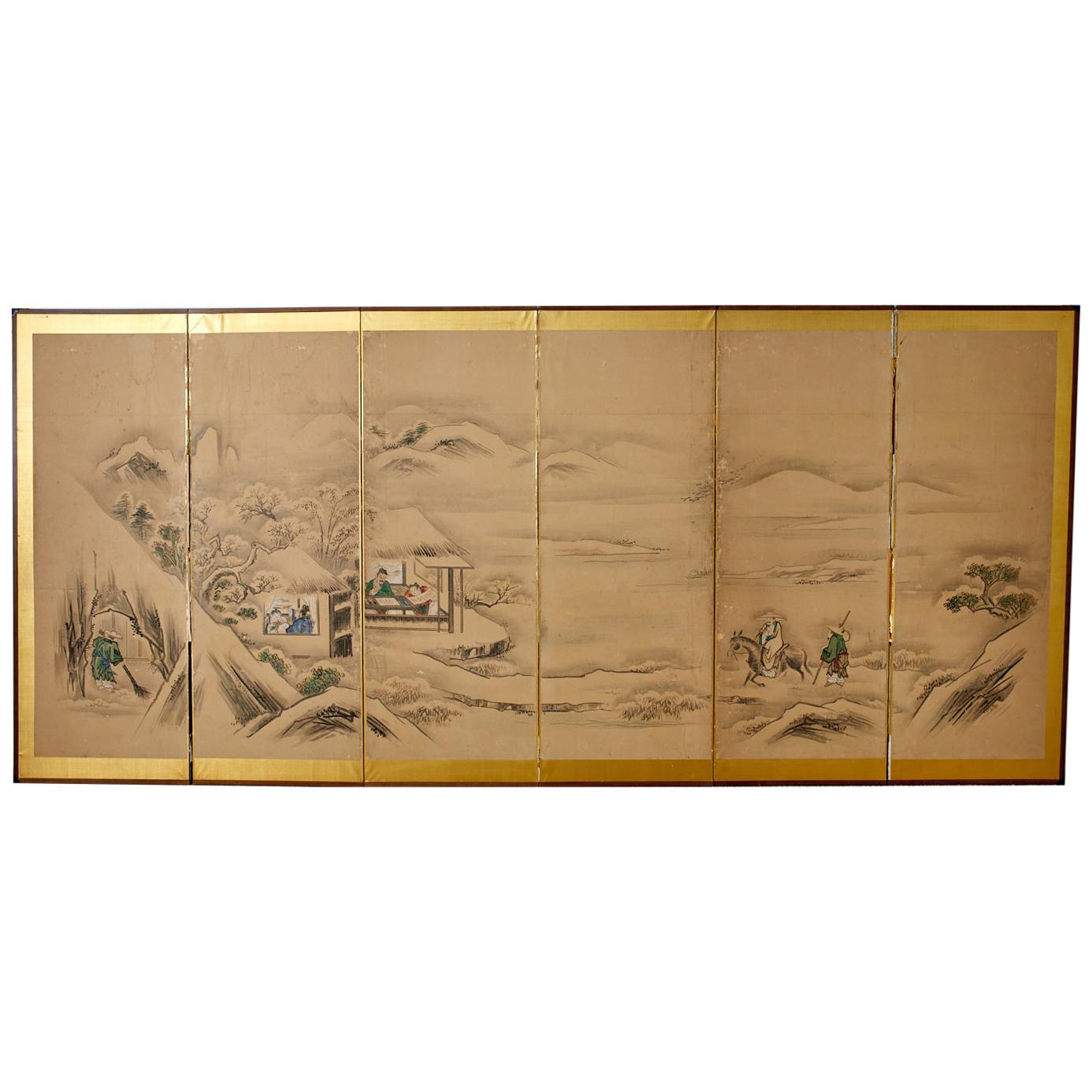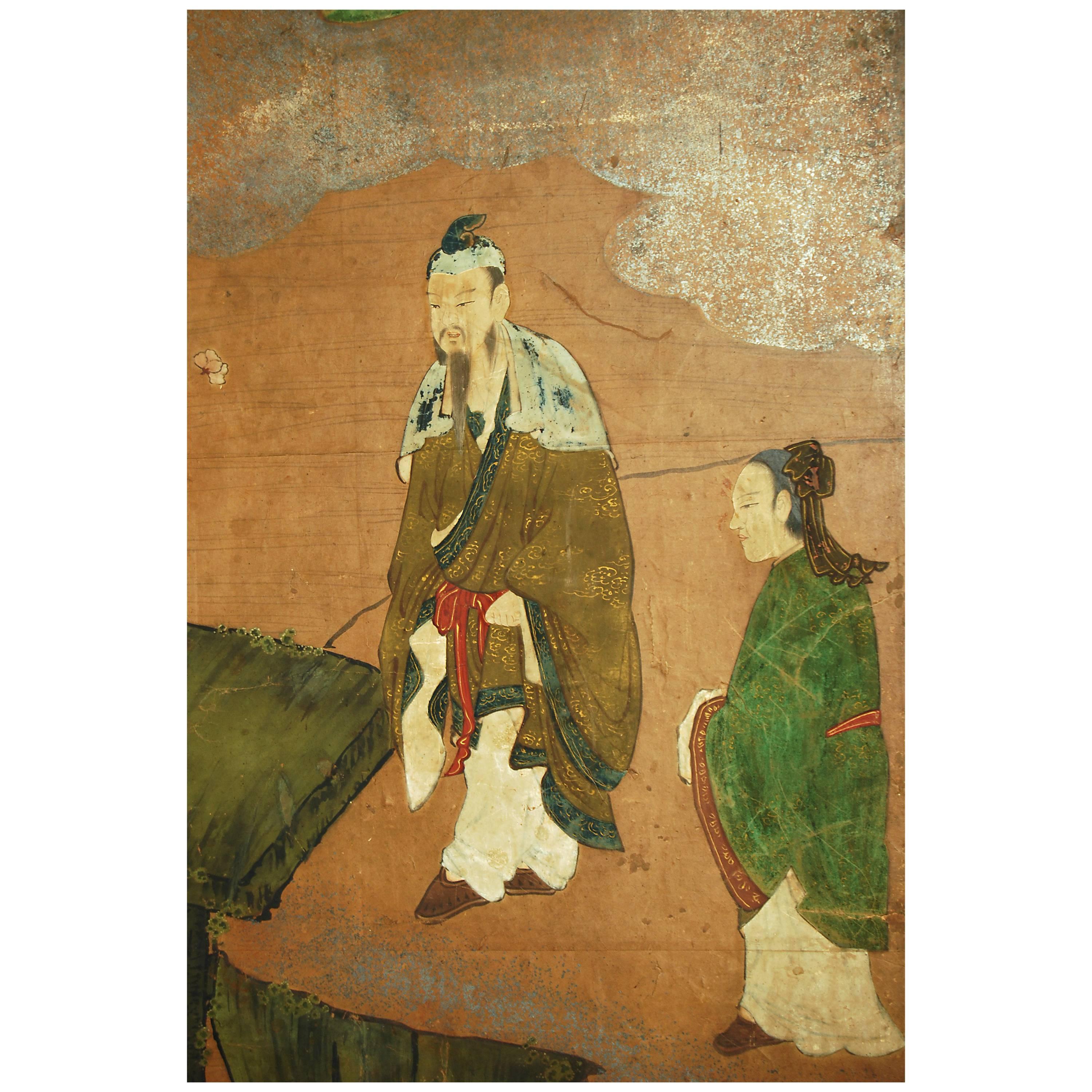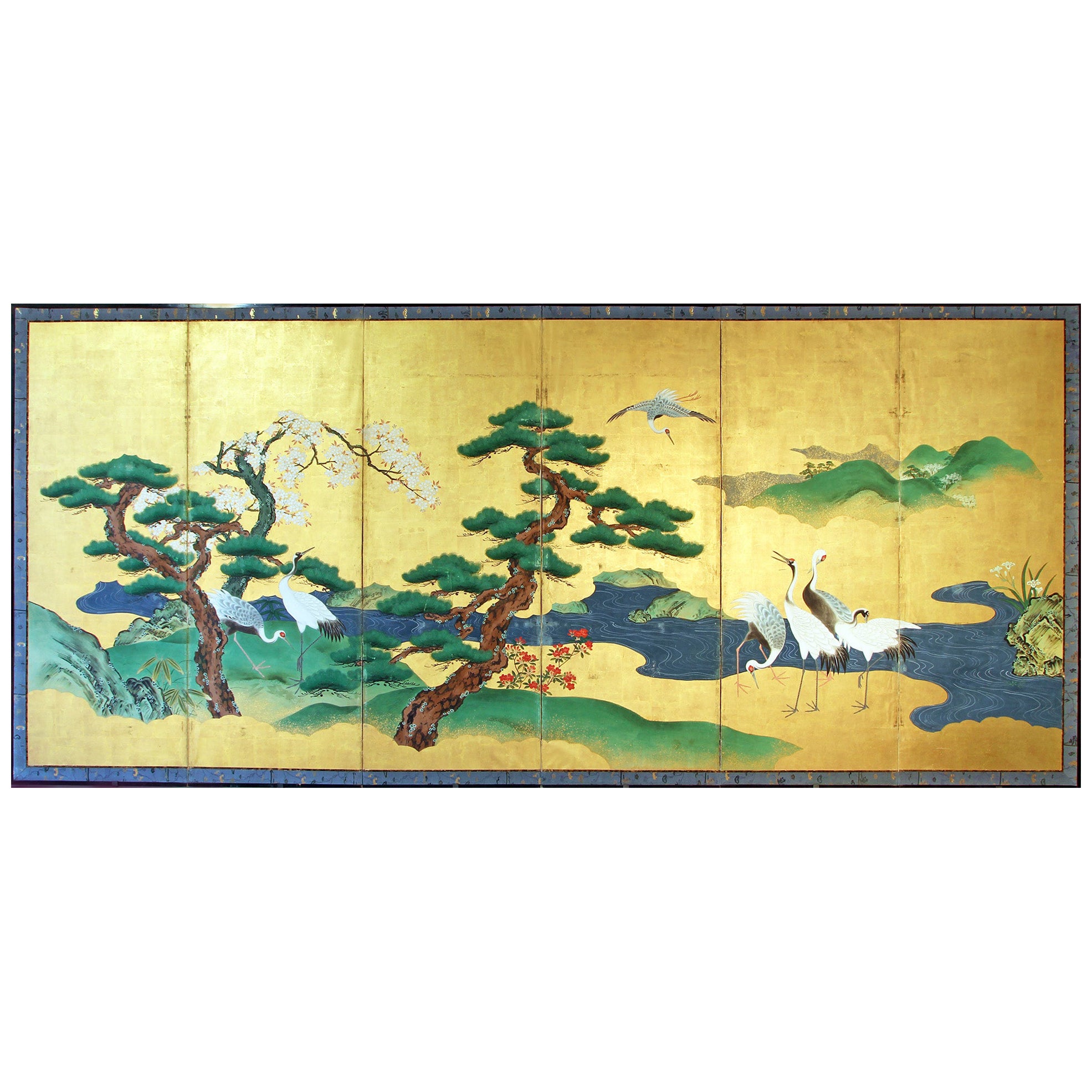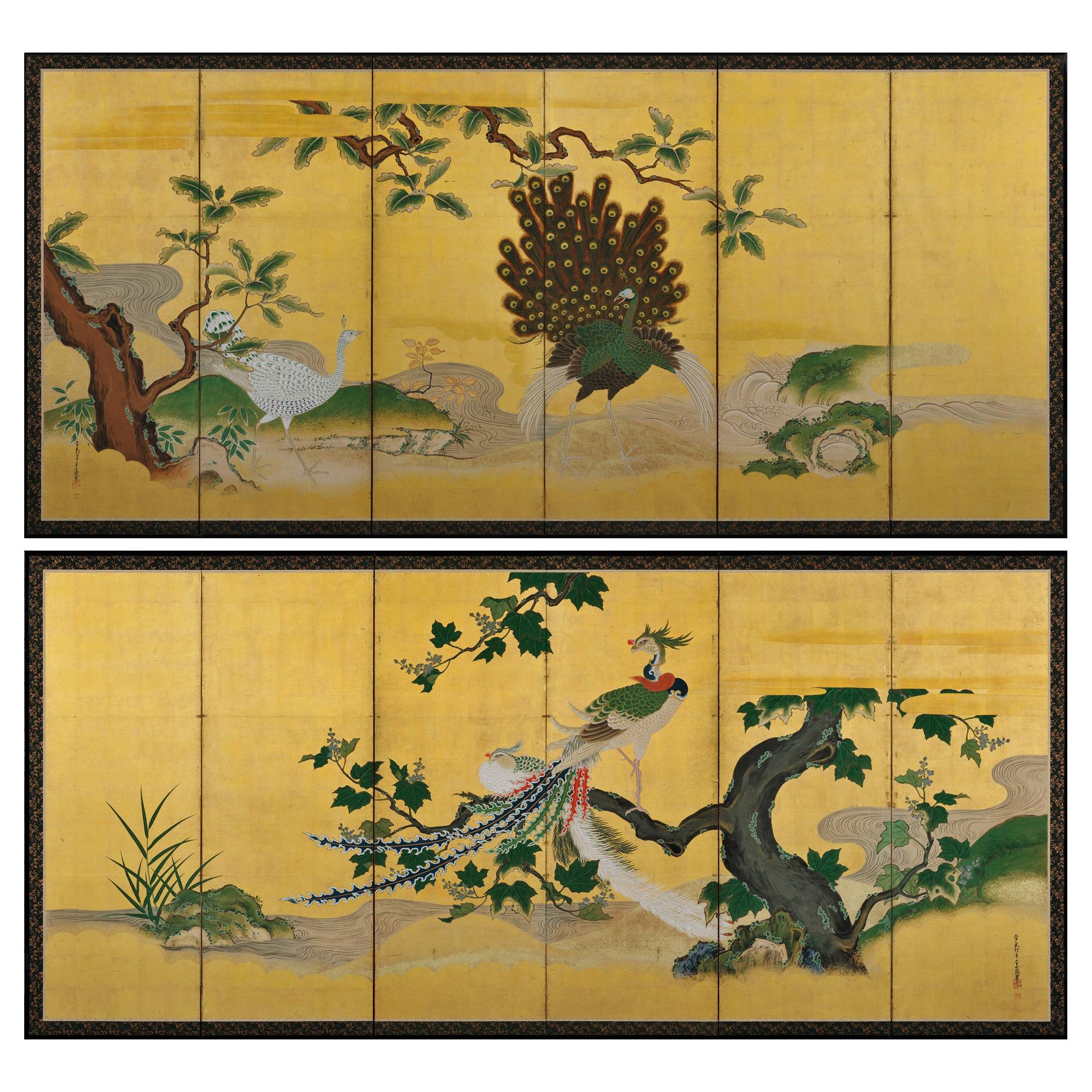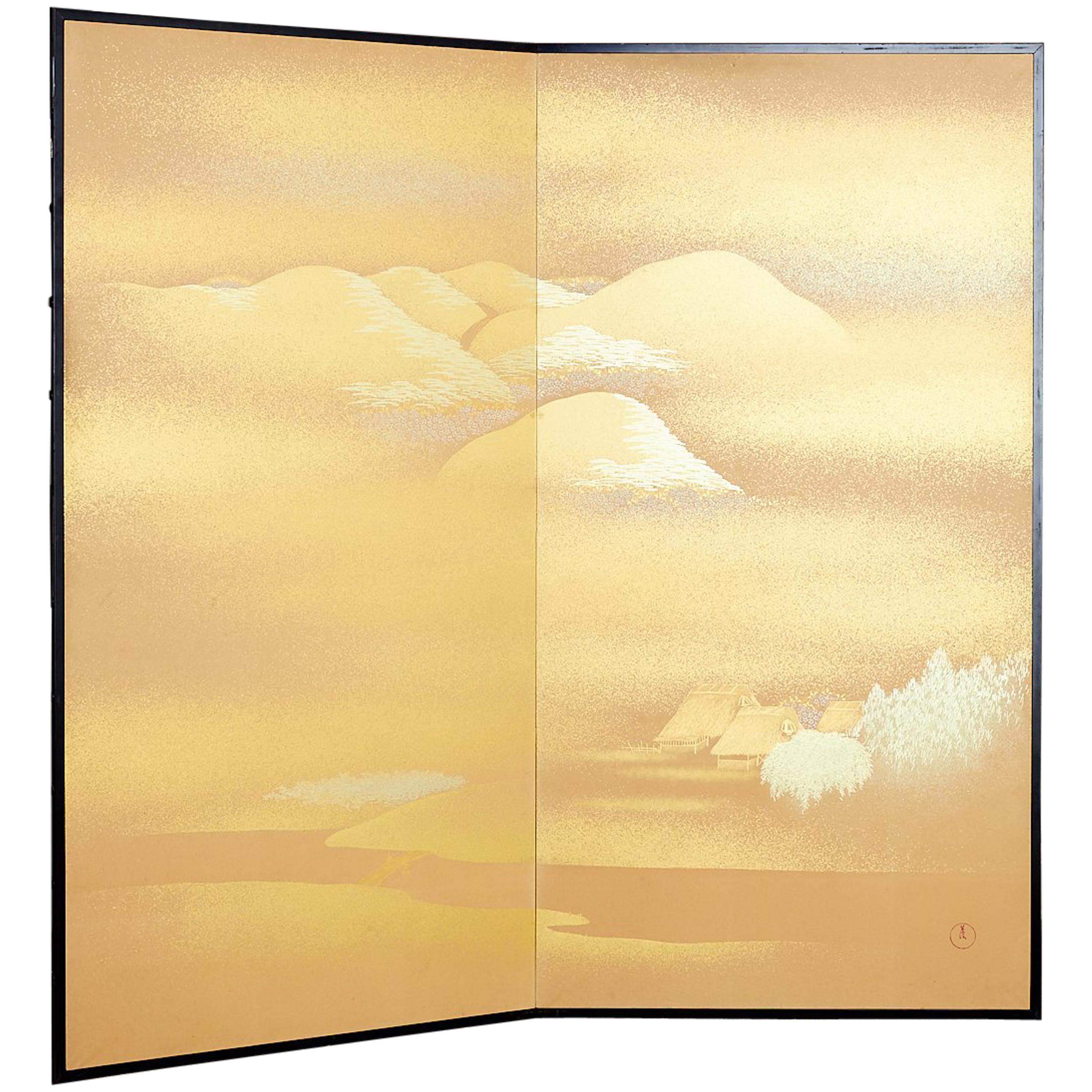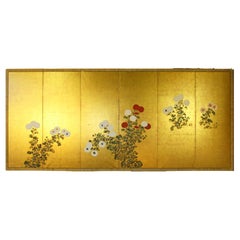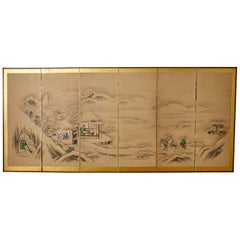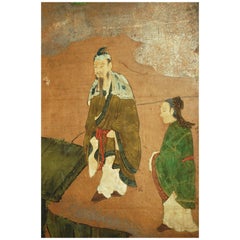
Asian Japanese Folding Screen Landscape, " Sansui ", on Gold Leaf - Kano School
View Similar Items
Want more images or videos?
Request additional images or videos from the seller
1 of 8
Asian Japanese Folding Screen Landscape, " Sansui ", on Gold Leaf - Kano School
About the Item
- Dimensions:Height: 47.25 in (120 cm)Width: 139.77 in (355 cm)Depth: 0.79 in (2 cm)
- Style:Meiji (Of the Period)
- Materials and Techniques:
- Place of Origin:
- Period:
- Date of Manufacture:circa 1880
- Condition:
- Seller Location:Brescia, IT
- Reference Number:1stDibs: LU5628228603042
About the Seller
5.0
Recognized Seller
These prestigious sellers are industry leaders and represent the highest echelon for item quality and design.
Established in 1981
1stDibs seller since 2021
15 sales on 1stDibs
Typical response time: 3 hours
More From This SellerView All
- Japanese Folding Screen Six Panels Painted on Gold LeafBy Japanese StudioLocated in Brescia, ITParavento a sei pannelli di scuola giapponese Kano: paesaggio con bellissime ed eleganti gru vicino al fiume, con alberi di pino e sakura. Dipinto a mano con pigmenti minerali ed inc...Category
Antique Early 19th Century Japanese Edo Paintings and Screens
MaterialsGold Leaf
- Japanese Screen of Spring on Gold LeafLocated in Brescia, ITIt is a two-panel screen from the Taisho period, around 1920, beautifully painted in excellent detail. The best of Rinpa's school painting: large empty space that highlights a pair of mandarin ducks in the middle of the pond. On the right, flying birds give the painting a great lightness, under many multicolored flowers they celebrate spring. All very proportionate and pleasant, the dimension really interesting. Mineral pigments on gold leaf. It turns out Anonymous. Lucio Morini.Category
Early 20th Century Japanese Taisho Paintings and Screens
MaterialsGold Leaf
- Six-Panel Japanese Screen on Spring Gold LeafLocated in Brescia, ITSpring landscape by an unknown painter of the Rinpa school, 19th century, six-panel ink painted on gold leaf on rice paper. The flowers are made with the "gofun" technique, natural or pigmented white oyster powder. Rinpa (? ?, Rinpa) is one of the major historical schools of Japanese painting. the style was consolidated by the brothers Ogata Korin (1658–1716) and Ogata Kenzan...Category
Antique Late 19th Century Japanese Edo Paintings and Screens
MaterialsGold Leaf
- Edo Period 19th Century Japanese Folding Screen Six Panels Flowers on Gold LeafBy Rimpa SchoolLocated in Brescia, ITClouds of gold, water and many colorful flowers: Japanese six-panel folding screen by Rimpa School. Hand painted with rice mineral pigments and inks on rice paper and gold leaf.Category
Antique Early 19th Century Japanese Edo Paintings and Screens
MaterialsGold Leaf
- Landscape with Flowers, Japanese Folding ScreenLocated in Brescia, ITSix-panel screen of the "Rinpa school", painted with inks on gold leaf. Colorful and sunny variety of flowers painted with great skill by an anonymous Japanese artist, who skilfully...Category
Antique Early 19th Century Japanese Meiji Paintings and Screens
MaterialsGold Leaf
- Edo Landscape Japanese Folding ScreenBy Japanese StudioLocated in Brescia, ITRefined work by a painter from the first half of the 19th century, from the landscape of the "Rinpa" school by a painter from the end of the 18th century, the Rinpa school. Six panels painted in ink on gold leaf and "gofun" on vegetable paper. The flowers are made with the "gofun" technique, natural or pigmented white oyster powder. Rinpa is one of the major historical schools of Japanese painting. The style was consolidated by the brothers Ogata Korin (1658–1716) and Ogata Kenzan (1663–1743). This folding screen has a very clean design that leaves plenty of room for the beautiful golden landscape. It comes flat and you can easily hang it with our hooks. Lucio Morini...Category
Antique 18th Century Japanese Edo Paintings and Screens
MaterialsGold Leaf
You May Also Like
- Japanese Six Panel Kano School Winter Landscape ScreenLocated in Rio Vista, CALarge Japanese Meiji period six-panel screen depicting a winter landscape with a Chinese sage visiting friends in a country villa. Ink and vivid color pigments on mulberry paper mounted to a gilt background. Painted in the 19th century Kano school...Category
Antique 19th Century Japanese Meiji Paintings and Screens
MaterialsMetal
- 18th Century Japanese Kano School Landscape ScreenLocated in Prahran, VictoriaJapanese Kano school screen with pine tree, camellias, cherry blossom and Chinese figures in the landscape, circa 18th century. Materials: Pigmen...Category
Antique 18th Century Japanese Paintings and Screens
MaterialsSilver Leaf
- 19th Century Japanese Edo Six Panel Kano School Landscape ScreenLocated in Rio Vista, CALate Edo period 19th century Japanese six-panel landscape screen featuring a cypress tree over a flowering hibiscus with a pair of hototogisu birds. Kano school painted with ink and ...Category
Antique 19th Century Japanese Edo Paintings and Screens
MaterialsSilk, Wood, Paper
- Japanese Screen Pair, circa 1730, Peacocks and Phoenix, Kano SchoolLocated in Kyoto, JPPhoenix and Peacocks. A pair of six-panel Japanese folding screens by Tsunetake Yotei (n.d.) First half of the 18th century. The signature reads 67 year old Tsunetake. The seals read: -Tsunetake no in, -Yotei, -Seishin Dimensions: Each screen – H. 69” x W. 149” (176 cm x 378 cm) A pair of Kano Grand Picture (Waga) screens depicting phoenix and peacocks rich with symbolic meaning. Dating to the first half of the 18th century, from the Kobikicho Kano school in Edo, this pair of folding...Category
Antique Early 18th Century Asian Edo Paintings and Screens
MaterialsGold Leaf
- Circa 1700 Japanese Screen Pair, Cranes & Pines, Kyoto Kano SchoolLocated in Kyoto, JPPines and Cranes Anonymous. Kyoto Kano School. Late 17th/early 18th centuries, circa 1700. Pair of six-panel Japanese folding screens. Ink, gofun, pigment and gold leaf on paper. This bold composition presents two pine trees extending to the left and right across a gold leaf background. One tree is silhouetted against a green ground, golden clouds obscuring its true size, the other stretches across a stylized waterway. The pines are paired with Manchurian cranes with red crests and snow white plumage. Both have been highly auspicious motifs in East Asia since Chinese antiquity. Here the artist utilized fluid and instinctive ink brushstrokes to define the trunk, branches and tail feathers, in strong contrast to the precision and sharp angularity of the crane’s legs and beaks. The adoption of this vast metallic painting support required an unerring sense of design and composition, so that the negative space surrounding motifs could imply context for the otherwise floating pictorial elements. The brushwork detailing the trunks of the pines, the exaggerated dimensions of the pine trees and the strength and dynamism of the composition are all reminiscent of Kano Eitoku...Category
Antique Late 17th Century Japanese Edo Paintings and Screens
MaterialsGold Leaf
- Japanese Two-Panel Gold Leaf Screen by YoshikawaLocated in Rio Vista, CAStunning Japanese two-panel folding screen featuring a gold leaf landscape signed by Yoshikawa. Delicate scene of cherry and willow trees near a village with high mountains in the ba...Category
20th Century Chinese Meiji Paintings and Screens
MaterialsBrass, Gold Leaf
$6,000 Sale Price20% Off
Recently Viewed
View AllMore Ways To Browse
Japanese Hooks
Eight Panel Screen
Kano School Screen
Japanese Screen Kano School
Japanese Folding Screen 19th Century
Kano Panel
Japanese Silver Leaf Screen
Silver Folding Screen
Japanese Screen With Silver Leaf
Meiji Folding Screens
Silver Leaf Folding Screen
Gold Silver Leaf Japanese Screen
Japanese Screen Sun
Japanese Screen Gold On Gold Sun
Chinese Folding
Pines Japanese
Asian Framed Gold
19th Century Chinese Screen
